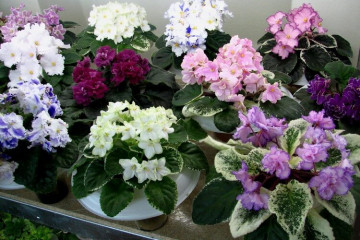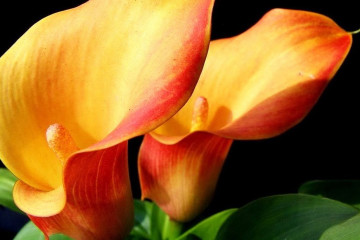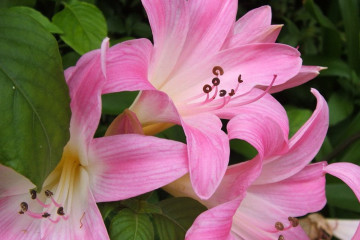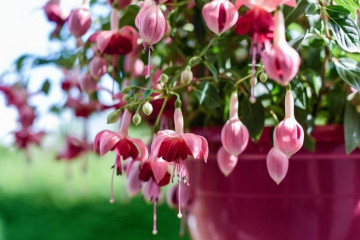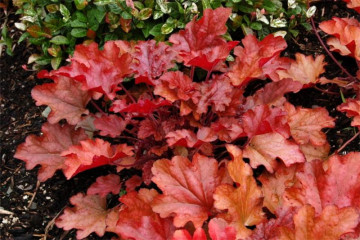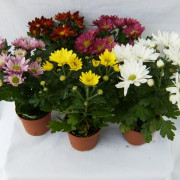Osteospermum flower - varieties and varieties
Content:
African chamomile, Cape daisy or osteospermum is a flower designed for garden decoration. A native of the tropics feels good in the conditions of the Middle Lane. The shrub is unpretentious to care for, has a long flowering, bright palette.
Gardeners appreciate this unusual plant, which looks like a chamomile, for its numerous flat buds with dense petals. The shrub retains its decorative effect for a long time, paints any landscape.
Origin and appearance of osteospermum
In natural conditions - on the Arabian Peninsula, in the hot countries of Africa, botanists have found more than 70 representatives of the family. There, the osteospermum flower does not shed its foliage, but only stops flowering for a short time. In temperate climates, the plant opens its first inflorescences in June, continues flowering until frost.
Osteospermum flower description
Osteospermum is a herbaceous perennial shrub of the Asteraceae family, a representative of the Asteraceae species. Stems from 20 cm to a meter high form a loose bush. Stems are erect, well branched. Inflorescences-baskets with one row of ligulate flowers with a diameter of 2 to 8 cm, in the center are tubular flowers of a contrasting color (smoky, blue, blue, black) with yellow pistils. After flowering, they form an achene with a dark long seed.
Osteospermum flower: perennial or annual
Under natural conditions, conservatories are grown as a perennial. On personal plots - as an annual crop.
Dimorphoteka and osteospermum: are they the same or not?
Plants belong to the same type of asteraceae, their buds are similar in structure and color. Gardeners often confuse dimorphoteka and osteospermum, but these are not the same plant, but two different ones. The first has glossy flowers, slightly collected towards the center. The second has a matte, disc-shaped bud with a dense wrapper of green small leaves. You can recognize dimorphoteka:
- at the core: it is always brown, there are no other options;
- colors: there are salmon, orange, light cream;
- seeds: they are flat in an oval shell;
- pubescent stem, fleshy leaves.
By the way, Dimorfoteka blooms for a short time, only in June. The flower in color, inflorescences outwardly resembles an ordinary calendula.
Types and varieties of osteospermum
The flower has long attracted the attention of breeders around the world. New varieties appear on the Russian market every year. But there are favorite ones that are in constant demand.
Osteospermum Sky and Ice
It is a vigorous variety, the height of the stems reaches 75 cm. It is distinguished by a rare color combination of reed and tubular flowers. The blue center emphasizes the snow-white of the bordering petals. Emerald greens are a welcome addition. The shrub branches well, lays flower buds until late autumn.
Osteospermum Magic Yellow
The newly emerged bright yellow variety of African chamomile strikes with a sunny shade of petals. They do not fade, retain the color intensity until wilting. It is a medium-sized variety that forms into a compact bush.

The full name of the osteospermum "Magic Yellow" - Summer Hero Magic Yellow, is a variety of Dutch selection
Osteospermum Akila
Low-growing variety, suitable for indoor cultivation, bush height 20 cm, bud diameter 6 cm. Flowers are constantly renewed. When creating a winter break, it grows up to 7 years without a transplant. A wide range of varieties are presented, from white with a blue center to yellow with a gray center. Mixes are often sold that combine a variety of shades.
Osteospermum Eklona
A common flower variety known as the Cape daisy. This is a tall shrub that reaches a meter in height.
Osteospermum Pass
The smallest shrub, grows well in small flowerpots. A bush with a height of 15 to 25 cm is strewn with buds up to 5 cm in diameter. The varietal line includes colors: white, pink transitional, lavender, pale lilac, purple. There are hybrids with flattened petals in the middle.
Osteospermum Mix
Mixtures of medium-sized and low-growing species are used for landscaping, alpine lawns. Usually the shades are selected in the same color scheme, some seed producers add whites and darks for contrast. There are terry medium-sized mixes of osteospermum Double Parple, Flower Power and others.

The representative of the double variety Berry White, pink. The cap of central tubular flowers is crowned with rows of reed inflorescences
Planting osteospermum in open ground
Under natural conditions, the bushes reproduce by self-seeding. Tropical culture is afraid of return frosts, sudden changes between day and night temperatures. In the southern regions, on glazed balconies, loggias, you can often see osteospermum, growing it in decorative outrigger pots, on balconies is not uncommon. In the southern regions, the flower grows like a perennial in the open field.
Growing osteospermum from seeds
The seeds are immediately embedded in the soil, slightly pressed into them so that the birds do not eat them. It is convenient to plant large seeds one at a time, observing the interval between the bushes from 20 to 40 cm, depending on the height of the shoots. For seedlings, the seed is laid out on the ground in greenhouses, hotbeds, the soil is well moistened, covered with a film - they create tropical conditions.
What is needed to plant osteospermum? The shrub grows well, blooms profusely on neutral soil, fertilized with humus, mineral fertilizers. For an unpretentious osteospermum, planting and care is reduced to weeding, watering.
Optimal site for osteospermum
African chamomile loves the sun, tolerates partial shade well. Like all Asteraceae, the plant is prone to root rot. Flooded areas will not work. The earth should warm up well. With a high groundwater table, drainage is required.
How to feed osteospermum for lush flowering
To grow full-fledged bushes, handfuls of humus and ash are added to the planting holes. During the budding period, foliar dressing (spraying) with complex fertilizers for indoor plants is recommended. Minerals are diluted according to the instructions, then the volume of water is doubled so as not to burn the greens. You can feed the flowers at 3-week intervals. The prepared solution of superphosphate, potassium nitrate is added to water for irrigation, a concentration of 1: 3 is made (one part of the fertilizer is diluted with three parts of water).
Osteospermum: how to preserve in winter
In regions where the temperature does not drop below -10 ° C in winter, the bushes are well preserved under cover of branches, under a layer of peat. In temperate latitudes, the bushes are transferred to pots by the transfer method, brought into the house. The plant recovers well after transplanting. The bush will bloom until the end of December, then you need to pause, move the flower to a cool place, and reduce watering.
Why osteospermum does not bloom
In the heat, the plant stops blooming, and directs all its forces to the formation of testes. It is advisable to shade shrubs, arrange drip irrigation for coolness.
With an excess of nitrogen, greenery grows abundantly, the number of flower baskets decreases. If the plant is properly looked after, there will be no problems.
Reproduction
The flower propagates vegetatively and by seed. It is better to grow a varietal hybrid from a cut, then the plant will inherit all species characteristics. Gardeners do not collect seed material, but prefer to purchase it in specialized departments or on web resources. Seeds retain their germination capacity for 3 years.

Osteospermum, seeds. They are protected by a dense shell, for abundant flowering, they are recommended to be soaked in a biostimulant solution
Osteospermum: growing from seed - when to plant seedlings?
You can sow a flower:
- in cups;
- general capacities.
The seeds are pressed or covered with a 2 mm layer of soil. The container must be covered with a film, removed to heat. Open it after germination.
Most often, the reproduction of osteospermum is practiced by growing from seeds - when to plant seedlings, gardeners decide on their own. Planting dates are the same as for asters: March - early April. The March seedlings will bloom in June, the April seedlings in July.
Planting seedlings in open ground
Shoots are transplanted to a permanent place after recurrent frosts. Two weeks before planting, the plants are hardened: they are taken out into the street during the day. The interval of stay is gradually increased to 6 hours. After hardening, the shoots will steadily endure small nighttime cold snaps.
Propagation by cuttings
For cutting planting until spring, the uterine bush is kept warm: at home or on a glazed loggia. The recommended winter temperature is + 12-15 ° C. The earth lump is moistened, not allowed to dry out completely.
The stalk is made from the top of the stem. In water, it quickly takes root, takes root well in loose nutrient soil. Non-flowering young shoots are taken from plants growing as indoor flowers.
Osteospermum: growing in pots
For the house, they choose undersized and medium-sized species. The winter break is made from the end of December to March, while the daylight hours are short. In the spring, the plant is loosened, fed, watered with fertilizer once a week.
Growing osteospermum from seeds at home
For planting, they immediately select a pot in which the plant will remain for several years. It is ¼ filled with expanded clay, and the top is filled with a loose soil mixture. The bush is grown as seedlings, only they are not transferred to open ground, but left on the windowsill. In the summer, the plant is taken out into the open space.
Choosing a container for planting
A planter for a flower will not work, you need a pot with a hole to drain the water.The root system extends to ½ the diameter of the bush, the capacity should be wide.
Watering and feeding
It is better to choose liquid ready-made dressings, they are added to the water for irrigation at the rate of ¼ of the recommended amount. Astrovids do not like an overabundance of trace elements, they can get sick.
With insufficient watering, the inflorescence baskets become smaller. With excess moisture, root rot develops.
Subject to the basic rules of agricultural technology, the plant will delight with flowers for a long period. The dense petals of African daisies do not lose their fresh appearance for a long time. The plant is suitable for summer cottages, city flower beds, and home cultivation.


